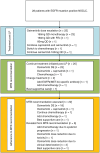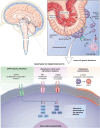Osimertinib-induced DNA resistance mutations in cerebrospinal fluid of epidermal growth factor receptor-mutated non-small-cell lung carcinoma patients developing leptomeningeal metastases: Osimertinib Resistance Analysis-leptomeningeal metastases study
- PMID: 39110039
- PMCID: PMC11630515
- DOI: 10.1093/neuonc/noae138
Osimertinib-induced DNA resistance mutations in cerebrospinal fluid of epidermal growth factor receptor-mutated non-small-cell lung carcinoma patients developing leptomeningeal metastases: Osimertinib Resistance Analysis-leptomeningeal metastases study
Abstract
Background: Diagnosis and treatment of leptomeningeal metastases (LM) in epidermal growth factor receptor mutation-positive (EGFRm +) non-small-cell lung carcinoma (NSCLC) is challenging. We aimed to identify resistance mechanisms (RM) to osimertinib in cerebrospinal fluid (CSF) and plasma.
Methods: EGFRm + patients with new or progressive LM during osimertinib were enrolled. NGS Ampliseq was performed on DNA isolated from CSF. Patients were prescribed osimertinib dose escalation (DE, 160 mg QD) following lumbar puncture. Clinical and radiological response was evaluated 4 weeks after osimertinib DE.
Results: Twenty-eight patients were included. The driver mutation was identified in 93% of CSF samples (n = 26). Seven (27%) harbored ≥1 RM. Twenty-five patients (89%) were prescribed osimertinib DE. Four weeks afterwards, symptoms improved in 5 patients, stabilized in 9 and worsened in 11 patients. Twenty-one (84%) patients underwent MR imaging. Four showed radiological improvement, 14 stabilization, and 3 worsening.
Conclusions: In 27% of patients, an RM was found in CSF ctDNA, none of which are targetable at the time of writing, and the clinical efficacy of osimertinib DE seems limited. There is much to gain in diagnostic as well as therapeutic strategies in EGFRm + NSCLC LM.
Keywords: EGFR; NSCLC; leptomeningeal metastases; osimertinib; resistance.
© The Author(s) 2024. Published by Oxford University Press on behalf of the Society for Neuro-Oncology. All rights reserved. For commercial re-use, please contact reprints@oup.com for reprints and translation rights for reprints. All other permissions can be obtained through our RightsLink service via the Permissions link on the article page on our site—for further information please contact journals.permissions@oup.com.
Conflict of interest statement
J.W.T.v.d.W., M.C.B., M.J., S.A.S., K.W.M., M.J.A.L., A.C., R.P.B.B., N.S. and D.v.d.B. report no conflict of interest. K.M. reports consulting fees from Lilly, Bayer, and Amgen, all paid to the institution. E.F.S. reports consulting fees from Eli Lilly, AstraZeneca, MSD, Merck, BMS, DSI, Takeda, and Boehringer Ingelheim, all financial compensation paid to the institution, payment or honoraria for lectures, presentations, speaker bureaus, manuscript writing or educational events from BI, and participation on a Data Safety Monitoring Board of Advisory Board with DSI. A.J.L. reports grants from BMS, MSD, AstraZeneca, and Boehringer Ingelheim, all paid to the institution, and nonfinancial support from Merck Serono and Roche. D.B. reports grants from Gilead Sciences, and consultancy fees from Lilly Pharmaceuticals and Boehringer Ingelheim, all paid to the institution.
Figures




References
-
- Cheng H, Perez-Soler R.. Leptomeningeal metastases in non-small-cell lung cancer. Lancet Oncol. 2018;19(1):e43–e55. - PubMed
-
- Li YS, Jiang BY, Yang JJ, et al. Leptomeningeal metastases in patients with NSCLC with EGFR mutations. J Thorac Oncol. 2016;11(11):1962–1969. - PubMed
-
- Gleissner B, Chamberlain MC.. Neoplastic meningitis. Lancet Neurol. 2006;5(5):443–452. - PubMed
MeSH terms
Substances
Grants and funding
LinkOut - more resources
Full Text Sources
Medical
Research Materials
Miscellaneous

